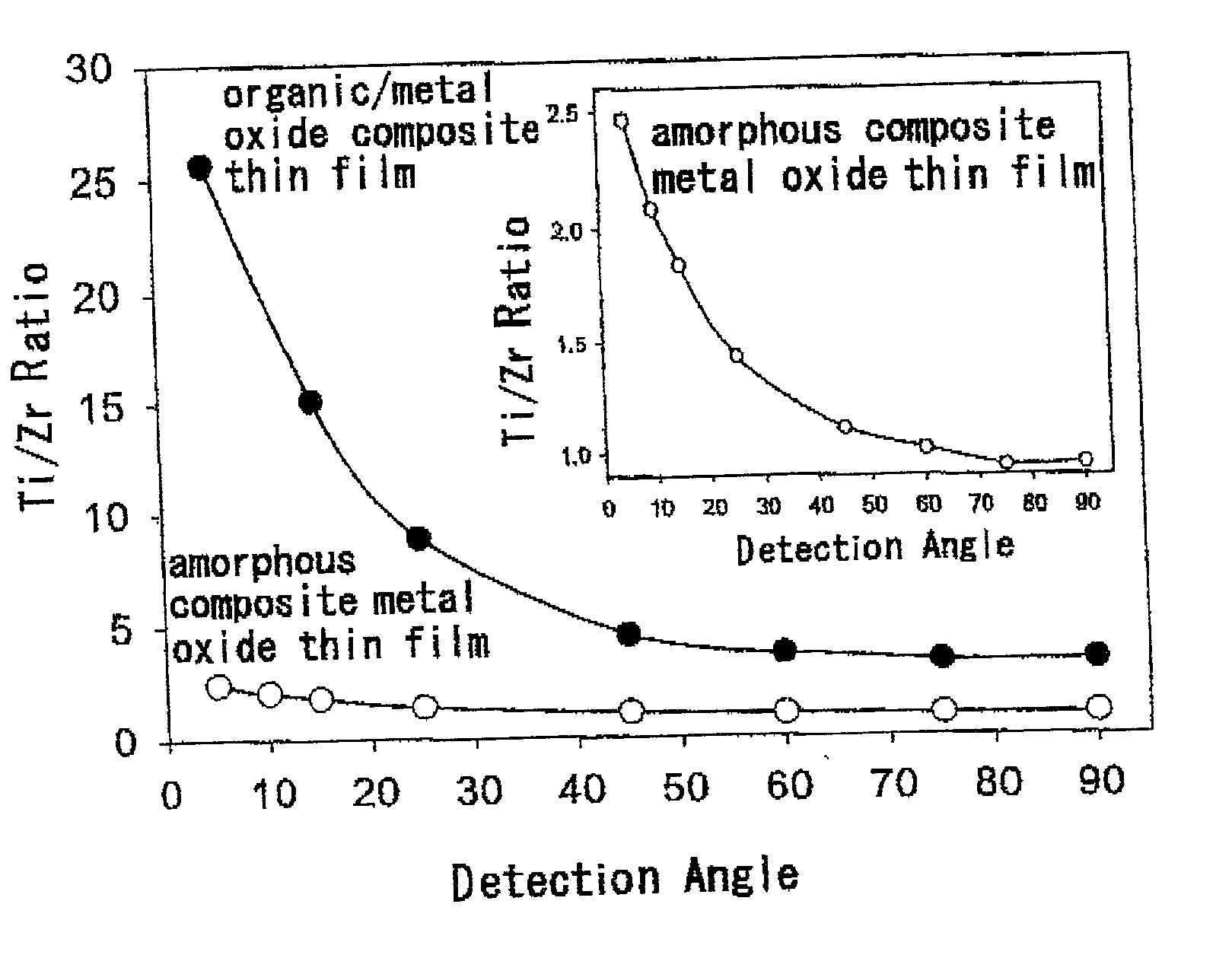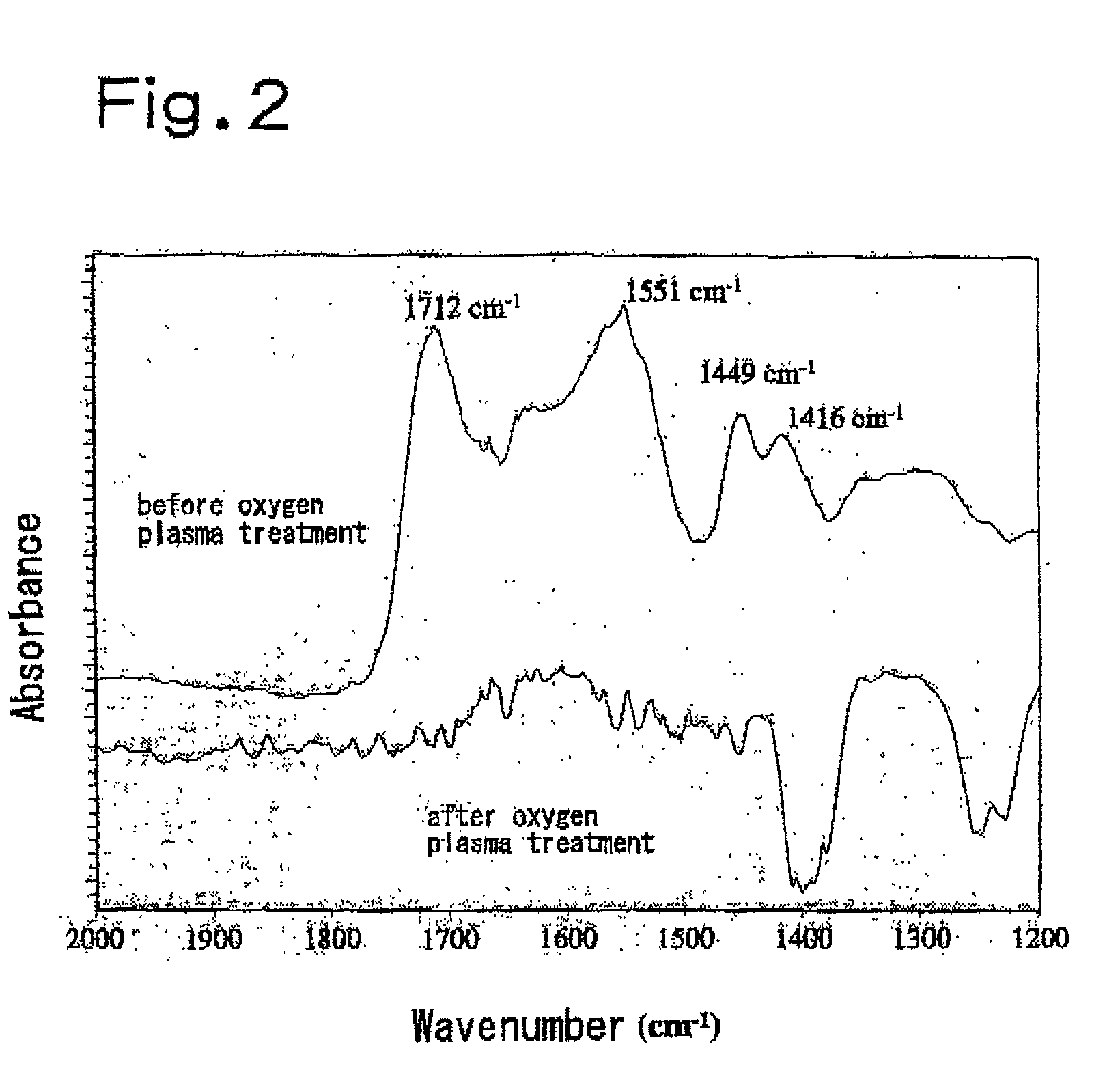Thin film materials of amorphous metal oxides
a metal oxide and film material technology, applied in the direction of zirconium oxides, solid-state diffusion coatings, liquid/solution decomposition chemical coatings, etc., can solve the problems of unpractical technique, inability to control the thickness in nanometer-level precision, and general inability to use metal oxides in cvd processes
- Summary
- Abstract
- Description
- Claims
- Application Information
AI Technical Summary
Benefits of technology
Problems solved by technology
Method used
Image
Examples
example 2
[0079] An organics / metal oxide composite thin film was produced according to method B in Example 2.
[0080] A 2:1 (v / v) mixed solvent of toluene and methanol was used to prepare 10 ml of a mixed solution containing titanium butoxide (Ti(O.sup.nBu).sub.4) in 100 mM concentration and 4-phenylazobenzoic acid in 25 mM concentration. The mixed solution was stirred at room temperature for 16 hours, added with 50 .mu.l of water, further stirred at room temperature for 4 hours, and diluted 20 times with toluene.
[0081] A quartz crystal microbalance resonator was dipped in thus obtained solution at 25.degree. C. for 1 minute, successively dipped in toluene at 25.degree. C. for 1 minute, blown with nitrogen gas to thereby dry it, and allowed to stand in the atmosphere while measuring the frequency of the quartz resonator. The frequency of the quartz resonator did not stabilize during a period of time that the alkoxide groups on the resonator substrate surface are being hydrolyzed, but became sta...
example 3
[0086] A newly cleft mica plate was dipped in an aqueous solution containing polydiaryldimetyl in the concentration of 1 mg / ml at 25.degree. C. for 2 minutes, and then in ion-exchanged water at 25.degree. C. for 1 minute. The mica plate was further dipped in aqueous solution containing polystyrenesulfonic acid in the concentration of 1 mg / ml at 25.degree. C. for 2 minutes, and successively in ion-exchanged water at 25.degree. C. for 1 minute. The mica plate was still further dipped in the foregoing aqueous polydiaryldimethyl solution at 25.degree. C. for 2 minutes, and successively in ion-exchanged water at 25.degree. C. for 1 minute to thereby produce on such mica plate a polymer ultra-thin film having the surface charged in positive. The resultant plate was then dipped in 0.27 wt % aqueous dispersion of polystyrene particles having carboxyl groups on the surface thereof (500 nm in diameter, commercial product) at room temperature for 10 minutes, to thereby allow such polystyrene p...
example 4
[0089] A newly-cleft mica plate was dipped in polydiaryldimetyl aqueous solution in the concentration of 1 mg / ml at 25.degree. C. for 2 minutes, and then in ion-exchanged water at 25.degree. C. for 1 minute. The mica plate was then dipped in polystyrenesulfonic acid aqueous solution in the concentration of 1 mg / ml at 25.degree. C. for 2 minutes, and successively in ion-exchanged water at 25.degree. C. for 1 minute. The mica plate was further dipped in the foregoing aqueous polydiaryldimethyl solution at 25.degree. C. for 2 minutes, and successively in ion-exchanged water at 25.degree. C. for 1 minute to thereby produce on such mica plate a polymer ultra-thin film having the surface charged in positive. The resultant plate was then dipped in 0.5 wt % aqueous dispersion of polystyrene particles having carboxyl groups on the surface thereof (500 nm in diameter, commercial product) at room temperature for 2 minutes, to thereby allow such polystyrene particles to adsorb onto the surface ...
PUM
| Property | Measurement | Unit |
|---|---|---|
| density | aaaaa | aaaaa |
| density | aaaaa | aaaaa |
| thickness | aaaaa | aaaaa |
Abstract
Description
Claims
Application Information
 Login to View More
Login to View More - R&D
- Intellectual Property
- Life Sciences
- Materials
- Tech Scout
- Unparalleled Data Quality
- Higher Quality Content
- 60% Fewer Hallucinations
Browse by: Latest US Patents, China's latest patents, Technical Efficacy Thesaurus, Application Domain, Technology Topic, Popular Technical Reports.
© 2025 PatSnap. All rights reserved.Legal|Privacy policy|Modern Slavery Act Transparency Statement|Sitemap|About US| Contact US: help@patsnap.com



